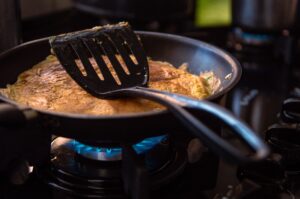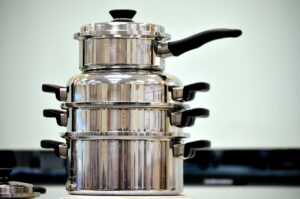Cooking with the right cookware is essential for making delicious meals. There are a variety of cookware materials available, including stainless steel and nonstick. While both materials have their own set of pros and cons, it can be difficult to decide which is better. In this blog post, we will explore the benefits of cooking with stainless steel vs nonstick – which is better?
Introduction to Stainless Steel vs Nonstick Cookware
Stainless steel and nonstick cookware are two of the most popular cookware materials on the market. Stainless steel cookware is known for its durability and resistance to stains, rust, and corrosion. It is also typically oven and dishwasher safe, making it easy to clean and use. Nonstick cookware, on the other hand, is made of a special coating that prevents food from sticking to the surface. Some nonstick cookware can also be used in the oven and dishwasher, but definitely not all brands. Check with the manufacturer, if in doubt.
The Pros and Cons of Cooking with Stainless Steel Cookware
When it comes to cooking with stainless steel, there are both pros and cons. Let’s take a closer look at the benefits and drawbacks of cooking with stainless steel.
Benefits of Cooking with Stainless Steel
- One of the biggest benefits of cooking with stainless steel is its durability.
- Stainless steel is a strong material that can withstand high heat and is less likely to warp or dent over time.
- It is also easy to clean and maintain, making it an ideal cookware material.
- Additionally, stainless steel cookware is oven and dishwasher safe, making it a great option for busy cooks.
- Another great benefit of cooking with stainless steel is its resistance to stains, rust, and corrosion. This means that your cookware will look like new for a long time, even with regular use.
- Stainless steel is also non-reactive, meaning it won’t absorb any flavors or odors from the food you’re cooking.
Drawbacks of Cooking with Stainless Steel
Despite its many benefits, there are also some drawbacks to cooking with stainless steel.
- One of the biggest drawbacks is that food can stick to the surface.
- If you’re not careful, it can be difficult to get food off of the cookware without damaging the surface.
- Additionally, stainless steel is a heavy material, making it a bit difficult to handle and store.
The Pros and Cons of Cooking with Nonstick
Nonstick cookware is popular for its ability to prevent food from sticking to the surface. Let’s take a closer look at the benefits and drawbacks of cooking with nonstick.
Benefits of Cooking with Nonstick
- The biggest benefit of cooking with nonstick is that food won’t stick to the surface.
- Nonstick is much easier to cook on and clean up after.
- Nonstick cookware is also very lightweight, making it easy to handle and store.
- Additionally, nonstick cookware is often dishwasher safe, making it a great option for busy cooks. Again, check with the manufacturer if you’re not sure.
Drawbacks of Cooking with Nonstick
Despite its many benefits, there are also some drawbacks to cooking with nonstick.
- One of the biggest drawbacks is that the nonstick coating can wear off over time.
- Due to the coating wearing off, nonstick cookware will need to be replaced more often.
- Additionally, nonstick cookware is not as durable as stainless steel and can warp or dent over time.

Health Risks Associated with Nonstick Cookware
While nonstick cookware has many benefits, it is important to be aware of the potential health risks associated with it. Nonstick cookware can emit toxic fumes when over-heated, which can be dangerous to inhale.
Additionally, if the nonstick coating is scratched or damaged, it can release chemicals into your food, and small flecks of the teflon can also fall off. For this reason, it is important to handle nonstick cookware with care and replace it when necessary.
There are no known health risks associated with stainless steel cookware.
Tips for Cooking with Nonstick and Stainless Steel
Now that we’ve explored the pros and cons of cooking with stainless steel vs nonstick cookware, let’s take a look at some tips for cooking with both materials.
When cooking with stainless steel, it is important to use the right tools. Use wooden or silicone utensils to prevent scratching the surface. You can also use a bit of oil or butter to help prevent sticking. When cooking with nonstick, it is important to avoid using high heat or metal utensils. This will help to preserve the nonstick coating and prevent it from being scratched or damaged.
Conclusion – Cooking With Stainless Steel vs Nonstick
Ultimately, the decision on which cookware material is best for you will depend on your cooking needs. If you are looking for a durable and easy-to-clean material, stainless steel is a great option. If you’re looking for a material that prevents sticking, nonstick is a great choice. However, it is important to be aware of the potential health risks associated with nonstick cookware.
Having said that most nonstick cookware are safe. The older generation teflon pots and pans did have some health issues. The issues were created when the teflon pots were heated beyond 570°F (300°C). The excessive heat would cause the teflon to break down and release fumes.
Some folks called it the Teflon Flu. The feelings one would get do mimmick flu-like symptoms. Chills, fever, body aches and headaches. More technically known as Polymer Fume Fever. Just be diligent. For my money, I go with pro level stainless steel cookware and cast iron.
No matter which cookware material you choose, it is important to use the right tools and handle it with care. With the right care and maintenance, your cookware will last for many years. If you found this cookware article helpful, why not check out these other articles!

